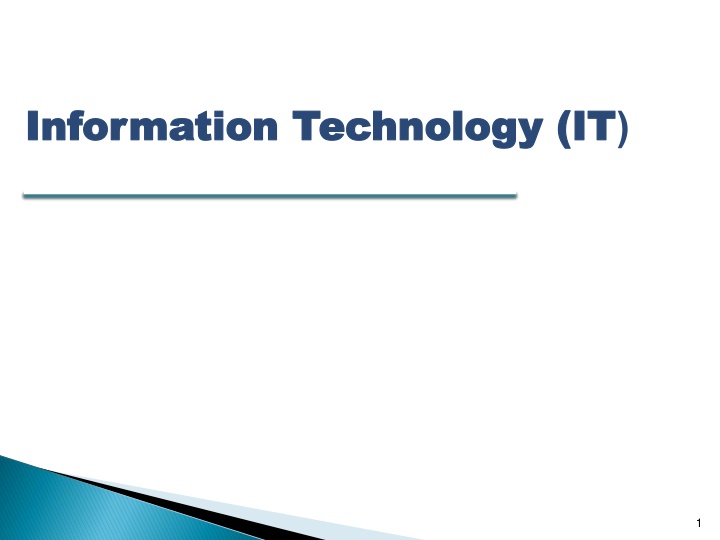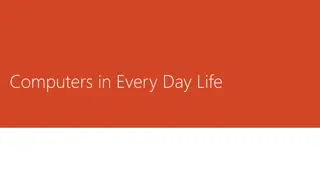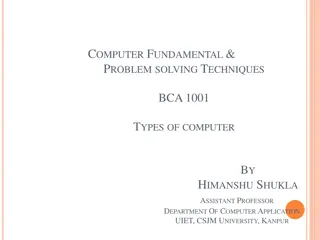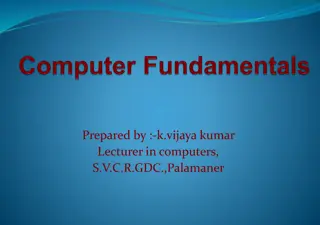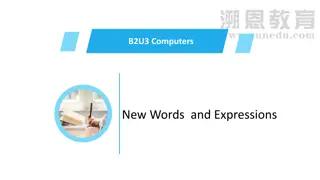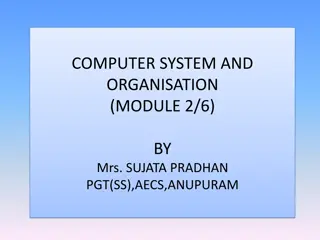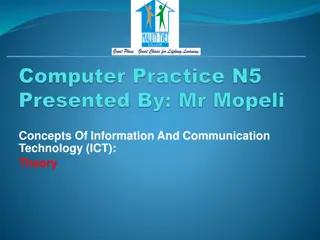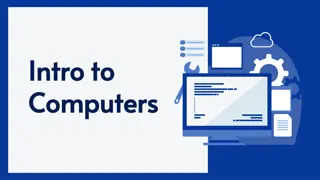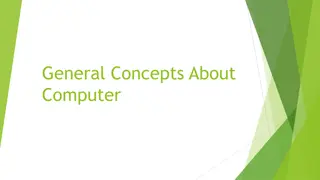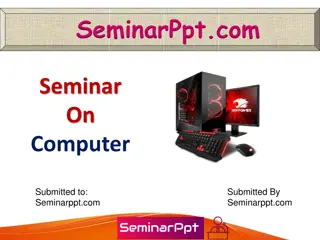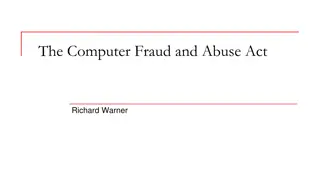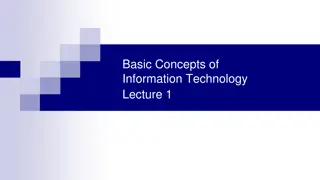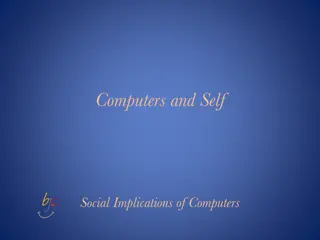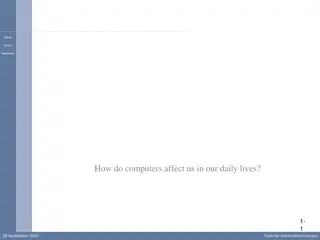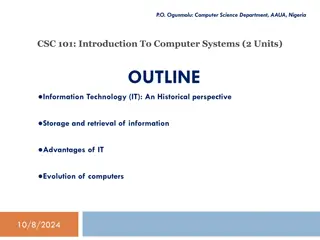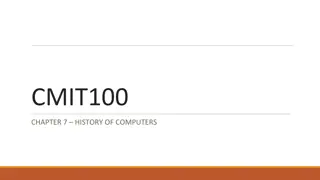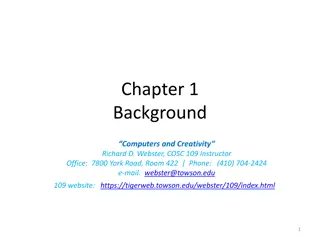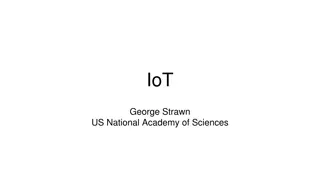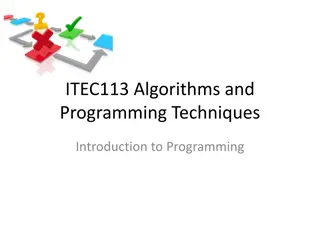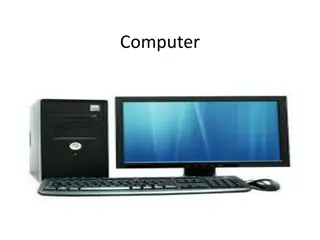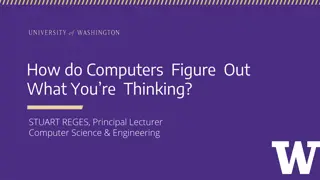Introduction to Information Technology and Computers
Information Technology (IT) involves using computers to gather, process, store, retrieve, and transfer information in various formats such as text, sound, pictures, and videos. Today, it is essential to work with Information and Communications Technology (ICT) due to the interconnected nature of computers. Computers are electronic devices that accept input, process data, and produce output based on stored instructions. They perform key functions like data processing, storage, and information generation. Various computer applications span across business, banking, education, healthcare, and more. Different generations of computers have evolved from vacuum tubes to ULSI microprocessors.
Download Presentation

Please find below an Image/Link to download the presentation.
The content on the website is provided AS IS for your information and personal use only. It may not be sold, licensed, or shared on other websites without obtaining consent from the author.If you encounter any issues during the download, it is possible that the publisher has removed the file from their server.
You are allowed to download the files provided on this website for personal or commercial use, subject to the condition that they are used lawfully. All files are the property of their respective owners.
The content on the website is provided AS IS for your information and personal use only. It may not be sold, licensed, or shared on other websites without obtaining consent from the author.
E N D
Presentation Transcript
Information Technology (IT Information Technology (IT( 1
Is a technology which uses computers to gather , process, store, retrieve, print, protect, and transfer information. These information can be text, sound, picture or video. 2
Today it is common to use the term information and communications technology (ICT)because it is unimaginable to work on a computer which is not connected to the network. Computer Computer A computer is an electronic device, operating under the control of instructions stored in its own memory that can accept data (input), process the data according to specified rules, produce information (output), 3
and store the information for future use. The amount of work that a computer can do is dependent on the size of its memory and the speed that it can operate at. Functionalities of a Functionalities of a computer computer Any digital computer carries out five functions in gross terms: 4
Step1- Takes data as input. Step2- Stores the data/instructions its memory and uses them as required. Step3- Processes the data and converts it into useful information. Step4- Generates the output. Step5- Controls all the above four steps. 5
Computer Applications Computer Applications 1. Business. 2. Banking. 3. Insurance. 4. Education. 5. Marketing. 6. Healthcare 7. Engineering Design. 8. Communication. 9. Military. 10.Government. 6
Generation & Description S.No Generation & Description First Generation The period of first generation: 1946-1959. Vacuum tube based. 1 Second Generation The period of second generation: 1959-1965. Transistor based. 2 Third Generation The period of third generation: 1965-1971. Integrated Circuit based. 3 Fourth Generation The period of fourth generation: 1971-1980. VLSI microprocessor based. 4 Fifth Generation The period of fifth generation: 1980-onwards. ULSI microprocessor based. 5 7
Computer types According to their capacity and performance, they are classified into the following: 1. Mainframes. Large (room size), powerful high speed and expensive computers. Often used within large systems(banks, government departments) and large organizations. Can be used by more than one user simultaneously. 8
Large storage capacities. They are connected to a large number of terminals. 2. Mini Computers: Do the same job as a mainframe, but on a smaller scale. Expensive but less than mainframe. 9
Big powerful. Very high speed but less than mainframe used by mid-sized companies. 3. Desktop or Personal Computer (PC): This is a general purpose computer made up of separate components: (monitor , keyboard, mouse, 10
processor and storage. Today: a single person can execute many tasks simultaneously (multitasking). Can be set on a desk. Cheap and easy to use therefore they are very popular. 11
4. Laptop computer or notebook: Relatively small, portable computers, easily carried around. Consists of LCD display and a small keyboard. Run on batteries. It is powerful as PC but more expensive. 12
5. Personal Digital Assistant - PDA (Palm): Small handheld computers with a touch screen which is called Notepad. Some have traditional keyboards behind or underneath the screen. Others display a keyboard on the screen. Some use handwriting recognition software to enter text. 13
Include satellite navigation facilities (GPS), mobile phone capability and versions of application software that have a limited range of functions. 6. Super computers: Computers with very high speed. Very powerful capacity for processing data. Used in large scientific and research laboratories, weather forecasting space operations. 14
Cost several million dollars. 7. Smartphones : This is an advanced mobile phone with the other features: web browsers, high- resolution touch screens , GPS navigation and Wi-Fi access. Smartphones are often used as media players and cameras. 15
8. Network connected computer: 8. Network connected computer: Every computer (PC, notebook, PDA) connected to the network is considered a network computer; can be connected either through network cable or through a phone line (at least to one more computer). A large PC- type computer called a server is connected to smaller PCs(network computer) called Clients or terminals. The server holds all applications and data , which it serves to the clients. 16
Computer Components 1 - Hardware : Refers to components of a computer system ,are the electronic and mechanical parts. The hardware cannot do anything without Software. 2-Software: Refers to components of a computer system are the data and the compute programs . 3-Users: A person who uses the software on the computer to do some tasks. 17
1- Hardware Basic components of Hardware are: A. Input Devices. B. Output Devices. C. System Unit: The following Diagram Shows the Main Units of the Computer. 18
A.Input Devices. Input device Translate data from that humans understand to one that the computer can work with. Examples: 1- Mouse 2-Keyboard 3-Light pen 4- Scanners 5-DiskDrives 6- Trackball 7-Touchpad 8-Touch screen 9- Joystick 10-Microphone 11- Stylus 12-Camera (web, digital) 20
13- Bar code reader 14- QR code reader 15- Magnetic card reader 16- Fingerprint Readers B. Out put Devices. Is How computer sends information back to you ,Examples: 21
1- Monitor: ( commonly called as Visual Display Unit (VDU). Characteristics of monitors: Color: The color depends on the type of the screen if it CRT or LCD and Graphic Adapter . Screen Size: When measured diagonally , the common sizes are: 15, 17, 19 and 21. 22
Resolution: The number of dots or pixels that can be display on the screen. (High resolution means better quality and a clear display). 2-Printer. 3-Plotters. 4- Removable Media 5-LED Displays (Light Emitting Diodes). 6-Loud speakers. 7-Speech synthesizer. 8-Projector. 23
C. System Unit: It is the Box, which contains The Center processing Unit (CPU), Main Memory, Drives, and the power supply. Central processing Unit (CPU): Every PCs-computer contains at least one chip called microprocessor or CPU, attached on the motherboard, 24
to perform computer processing its the brain of computer. It determines how fast your computer will run . The speed of the computer is measured by MHz (Mega Hertz) or GHz(Giga Hertz). Three main parts of a CPU 25
Arithmetic and logic Unit (ALU): Which perform every arithmetic operations (+,-/,....),& the logic operations (OR,AND,NOT). Control Unit (CU): manages the flow of data through the CPU. It directs data to and from the other components within the CPU. 26
Registers: are holding areas for both data and instructions. There are many different registers, each with its own special purpose. For example, there are registers that hold data, registers that hold instructions, registers that store logical states (yes/no), temporary values that serve as increment counters, and so on. 27
The functions of Control Unit: 1. Read and interpret the program's instruction. 2. Directs the movement of electric signals between memory and ALU and also between main memory and I/O Device. 3. It control every operation inside the CPU. 28
